Minetest
 | |
 | |
| Original author(s) | Perttu Ahola |
|---|---|
| Developer(s) | Minetest team |
| Initial release | 0.0.1 / November 2, 2010; 13 years ago (2010-11-02) |
| Stable release | 5.8.0[1] |
| Repository | github |
| Written in | C++, Lua |
| Engine | Irrlicht (Irrlicht-MT fork) |
| Platform | Microsoft Windows, MacOS, Linux, FreeBSD, Android |
| Type | Sandbox, survival |
| License | 2013: LGPL-2.1-or-later[2][3] 2010: GPL-2.0-or-later[4][5] Original: Proprietary[6] |
| Website | https://www.minetest.net/ |
Minetest is a free and open-source voxel game creation system. It is written primarily in C++ and makes use of the Irrlicht Engine. Minetest provides a Lua API allowing users to write their own games and mods. It is cross-platform, being available for Microsoft Windows, macOS, Linux, some BSD descendants, some GNU variants and Android.[7]
An in-game browser lets users download games and modifications from the ContentDB website.[8] The five most popular games by downloads are VoxeLibre, Minetest Game, NodeCore, Tutorial and Subway Miner.[9]
Over a decade of active development Minetest has garnered critical acclaim and gained in popularity; since November 2013 Minetest has been downloaded over 1.4 million times from GitHub[citation needed] , and the Android version of Minetest has over a million downloads on the Google Play store[10] .
Gameplay

The game world of all Minetest games is composed of voxels which are mostly cubes aligned in a 3D grid. However the player and creatures can move around freely. In Minetest voxels are called nodes. Different nodes represent various materials, such as dirt, stone, ores, tree trunks, water, and lava.
The most popular games for Minetest are VoxeLibre (formerly Mineclone2) and Minetest Game.[11] Both are sandbox building games.
VoxeLibre is a full game with animals, monsters, interesting biomes, whereas Minetest Game is a lifeless sandbox with mostly landscape nodes.
While technically playable without, Minetest Game relies on modifications to add creatures, more biomes, gameplay mechanics, armours, weapons, tools, decorative nodes and so on.
The gameplay of VoxeLibre revolves around picking up and placing these nodes, gathering materials, crafting items and nodes by placing them in a crafting grid in the inventory window, smelting ores in the oven, farming crops, animal husbandry, eating food and defeating monsters to survive. Some nodes can only be picked up with certain held tools the player has to craft.
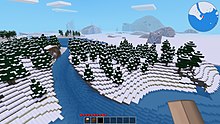
As players explore the world, new areas are procedurally generated, using a map seed specified by the player. A new game puts the player in the center of a voxel cube 62 thousand nodes across, so the player can travel 31 thousand nodes in any direction (sideways, up, or down)[12] before reaching the invisible wall at the end of the world.
The world is divided into biomes ranging from deserts to jungles to snowfields; the terrain includes plains, mountains, forests, caves, and various lava/water bodies. The in-game time system follows a day and night cycle, and one full cycle lasts 20 real-time minutes.
Minetest provides two play style options across games: Enable Damage and Creative Mode. Disabling damage prevents dying, thus losing items and the possible frustration it might cause and Creative Mode provides players with infinite resources to build whatever they want without having to gather them first.[13]
Multiplayer

Minetest offers players to play together over the internet or the local network by joining a server or hosting their own.
Players can either connect by IP or select the server from the built-in server browser if the host chose to publish it there by selecting the checkbox.
Instead of centralized account systems proprietary games use for the whole software, Minetest allows registering and logging into accounts on each individual server.
Customization

Minetest provides an interface for games and mods written in Lua. Mods are server-side and work out of the box when playing on servers, with no installation required.
Minetest features a built-in content browser showing packages uploaded to ContentDB, allowing users to install games, mods and texture packs with a single click. Over 2300 packages are available there as of May 2024[14] and many more on the forums.
-
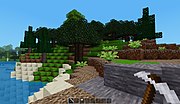 Default texture pack
Default texture pack -
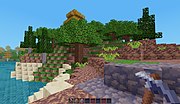 RPG16 texture pack
RPG16 texture pack -
 Hand Painted high resolution texture pack
Hand Painted high resolution texture pack
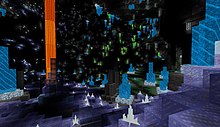
Mods can be used to add or modify nodes, gameplay mechanics, tools, weapons, armour, monsters, player skins and the user interface.
The full source code of Minetest and most of its games and their artistic assets such as textures and sounds, are distributed under free licenses, making it easier to publish modified versions and derivatives.
-
 Interior design using Home Decor mod
Interior design using Home Decor mod -
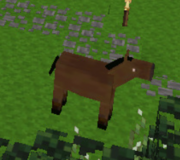 A horse from the Mob Horse mod
A horse from the Mob Horse mod
Development

Minetest was originally released in November 2010 under a proprietary license.[6] Shortly afterwards the license was changed to the GPL-2.0-or-later license.[5] By agreement among major contributors, in June 2012 the project license was to be changed to LGPL-2.1-or-later, though at the time small parts still remained under the GPL-2.0-or-later license.[4] In September 2013, the transition was complete.[3] While LGPL-2.1-or-later remains the main license for the Minetest engine, other free and open-source licenses are used for various other parts of the latest release.[2]
Perttu Ahola was the only developer working on the project for about six months, until Ciaran Gultnieks started making code contributions in May 2011.[15] The roster of contributors grew and changed over the years. As of July 2020, there are 9 active core developers and 15 active contributors. Project participants do not have set roles, but rather keep their activity within their respective areas of expertise. Perttu Ahola's role morphed over the years: whereas initially it was engine development, now it is mostly Web-hosting and administration, assigning core developer, moderator, and other roles to people, as well as being the final word in cases where other developers are unable to render a decision.[15]
Since version 5.0.0 the in-game browser lets users download games and modifications as well as their dependencies from a website called ContentDB.[8]
As of Minetest 5.8.0 the Minetest Engine no longer ships with a default game.[16]
Usage in education
Minetest has been used in educational environments to teach subjects such as mathematics, programming, and earth sciences. Such examples are:
- In 2017 in France, Minetest was used to teach calculus and trigonometry.[17]
- At Federal University of Santa Catarina in Brazil, Minetest was used to teach programming in a variant called MineScratch.[18]
- In 2018, for Laboratory Education and Apprenticeships (EDA) at the Paris Descartes University, Minetest was used to teach life and earth sciences to year 6 students who could not observe some phenomena in person but could experience them in the Minetest virtual world.[19]
Reception
Opensource.com listed Minetest at #1 in its "Best open source games of 2015",[20] stating that it is maybe "the most complete alternative to Minecraft", and noted its expansibility, stating that it contains a user-friendly API for creating mods in Lua.[21] PC Magazine listed Minetest among "The best Sandbox Creation Games for Minecraft Fans".[22]
See also
- Free and open source software
- List of open-source video games
- Open-source video game
- Linux gaming
- Sandbox game
- Survival game
- Minecraft






















